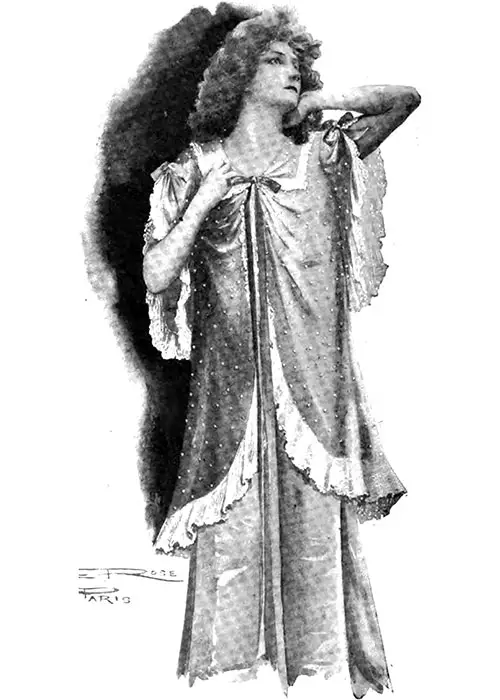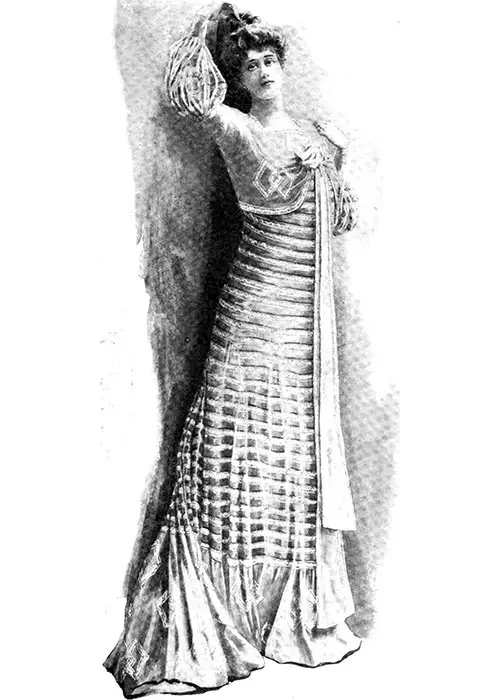Lingerie and Negligées 1901
As has been the case for some time and especially in all the fashions this spring, handwork is preferred to ornate machine-embroideries for rich laces on lingerie. Lace is used of course—it always is—but when real lace cannot be obtained, or an excellent imitation, then pretty stitching is greatly preferred.
It must be confessed that they do not cost much less than the lace, for hand-embroidery—the embroidery done on the material itself—can never be cheap, but it is so exquisite that one does not mind spending the money for it.
As dainty fads are the fashion at present, one is to choose some particular design and have that worked on all one’s lingerie. A woman who has lilies-of-the-valley for her favorite flower will have them worked on everything she wears and will use only white or green ribbons.
Where violets are the favorite flower, violets are chosen as the design. However, as violets are so small, the pattern is not an effective one and has to be supplemented by bow-knots. Roses and so on indefinitely, and always with the ribbons to match.

Summer Dressing Jacket of Pink Batiste with Raised White Dots; Frill of Lace All Around the Body, Sleeves, And Collar; Sleeves and Front Gathered Up with Pink Ribbons.
The idea is a pretty one and certainly gives an individuality, but through all the designs are scattered the tiny polka dots or embroidery knots which are so useful. Lace medallions are used when there is no other lace on the lingerie.
They should be of real lace if possible and appliqued on to the material. The newest corset covers are very long-waisted, made shorter in the back than in the front, to carry out the long line, and fitted with as much care as a dress waist.

Negligée of Pink Silk and Valenciennes
The combination of corset cover and petticoat in the very thinnest batiste is most beautifully executed, while the night-gowns made long and full are quite like wrappers in their designs.
The finest cambric and batiste are used for lingerie, and white is preferred to everything else. Silk lingerie has never been universally popular, although one set of silk is often included; but in petticoats, of course, the silk is used.
The petticoats that were used in Paris last year, with the embroidered flounces that are fastened on with buttons and button-holes are again fashionable this year, as are also those of dotted muslin with frills trimmed with lace, and with an additional flounce of taffeta silk that is buttoned on and that can be removed when the petticoat is sent to the laundry.
Every petticoat is fitted and hung with as much care as the skirt of the gown; and with good reason, for a lousy petticoat will utterly spoil the smartest skirt ever made. The petticoats of dotted muslin ought to be of rather heavy muslin and one that will take starch well.
The best model is one with the attached flounce that is wider at the back than in front, and with the fulness of the skirt in the very center of the back. The skirt must not be too wide, the width and flare being given by the flounce, which may be trimmed with ruffles or ruchings -- anything to make it stand out.
These dotted muslin petticoats have the body of the skirt, of course, made of a soft, thin lawn, which will fit smoothly over the hips. This should not be starched, whereas the two ruffles should be quite stiff.
Both may be trimmed with lace, with several rows of insertion, but the more general and sensible plan is to have only an edge of lace on the under flounce and edge, and insertions for the outer one.
The colored lawn petticoats, while most useful to wear under organdies or other muslins, are not a practical scheme for general use. They do not launder well, losing their delicate color and sheerness. However, they are sure to hold their popularity for under diaphanous gowns.
“Lingerie and Negligées,” in Harper's Bazar: A Weekly Magazine for Women, New York: Harper & Brothers, Vol. XXXIV, No. 10, 9 March 1901, p. 608-609.
Note: We have edited this text to correct grammatical errors and improve word choice to clarify the article for today’s readers. Changes made are typically minor, and we often left passive text “as is.” Those who need to quote the article directly should verify any changes by reviewing the original material.
